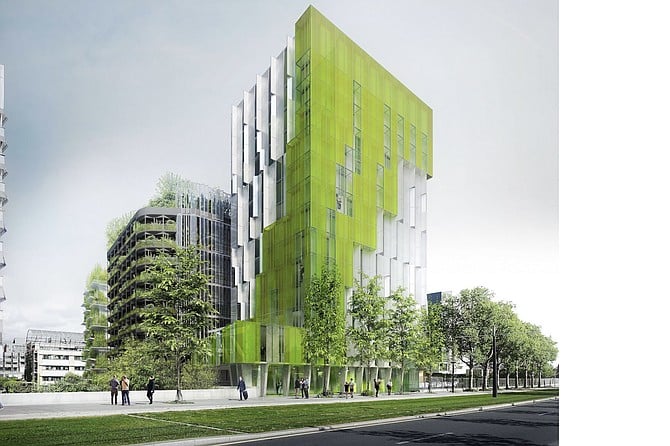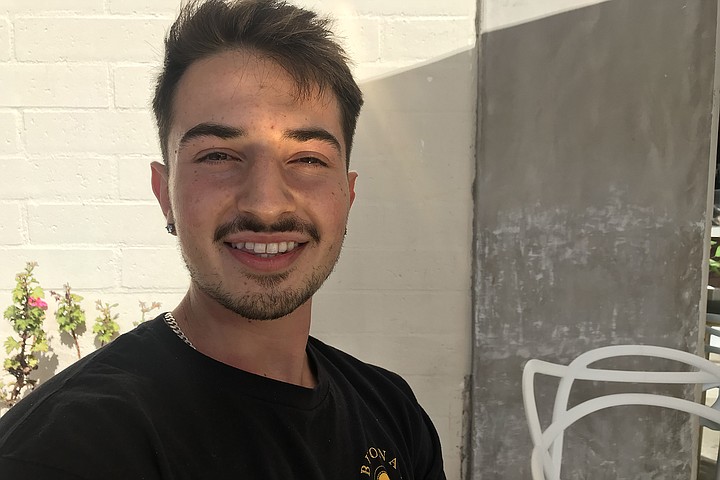 Facebook
Facebook
 X
X
 Instagram
Instagram
 TikTok
TikTok
 Youtube
Youtube

John Bucur is a barista in a San Diego coffee bar, but he’s got another life. A life filled with…algae.
“Here’s the thing about algae,” he says. “You can grow it anywhere. On parking building walls, or better still, next to cars’ exhausts. Algae love to munch car exhaust fumes and burp out oxygen. The built environment can be the perfect growing grounds for algae, which we can turn into biofuels — at the same time, eliminating CO2 from the air. Think of how walls with algae growing on them could become nature’s solar panels.”
At 23, Detroit native Bucur is already running a company, Airbuild, that’s seeking to develop algae into something that can save Mother Earth from the anthropogenically-caused explosion of CO2 gases in our daily lives. And — beautiful fact — after the algae has grown and done all that good, it can be turned into just about anything, from nutritional supplements to jet fuel. It sounds like a panacea for all our ills. Bucur talks of creating whole cities, designed and built as urban, oxygen-growing algae farms. He’s serious about this: “My dream for San Diego,” he says, “is to turn it into a green city. I mean literally green. Walls, roofs, all green from living algae. This may sound radical, but I see algae as nature’s solar panels.” That’s why he came here: for the sun, and for the investment-rich environment. In the meantime, he makes coffee and spreads the good green word. “Most of the people I have recruited are working in coffee shops by day. There’s a lot of us out here.”

But algae as a force for good? Isn’t that the green slime that turns ponds into lifeless, oxygen-deprived water, and drowns fishes? It’s all in the management, says Bucur. “Algae are the fastest-growing plants on earth. They can double their size every day. They convert sunlight, water, and CO2 into biomass, and then release large amounts of oxygen into the atmosphere.” What’s not to love? And yet, where’s the respect? He knows it’s going to be a long haul. “My whole life is dedicated to decarbonizing the world,” he says. “Algae is a transitional tool.”
He says the idea began growing when he saw a picture of a bridge in Sweden that had an algae photo-bioreactor on it. “The algae, mounted on the bridge in a set of tubes, was uniquely positioned to intercept the carbon monoxide emissions coming from the cars below. So cars’ exhaust is all going into this algae on the bridge, and it’s growing the algae, which is cleaning that small portion of air around the bridge. So I said, ‘We should take this and scale it up!’”
Already, he says, some existing algae companies are looking into setting up next to fossil-fuel power plants. “They’ll pump the emissions from that power plant right into their algae. In India, they’re planning to build 600 [fossil fuel-powered] power plants in the next 20 years. So we have to think of a way to help people efficiently transform those carbon dioxide emissions into oxygen. After I was inspired by the Swedish bridge, I talked to a bunch of engineers and biologists and formed a team from places like India and Nigeria, people far more brilliant than I could ever be. So now we have a company, we have the drive, and we have the ideas.”
His eyes brighten. “And what if we built parking structures right next to power plants, so we could be creating oxygen directly from their toxic waste? It’s like we put 1000 trees in a parking lot when we do this, from the oxygen the algae create.”
He leans over. “Ready for a refill there?”


John Bucur is a barista in a San Diego coffee bar, but he’s got another life. A life filled with…algae.
“Here’s the thing about algae,” he says. “You can grow it anywhere. On parking building walls, or better still, next to cars’ exhausts. Algae love to munch car exhaust fumes and burp out oxygen. The built environment can be the perfect growing grounds for algae, which we can turn into biofuels — at the same time, eliminating CO2 from the air. Think of how walls with algae growing on them could become nature’s solar panels.”
At 23, Detroit native Bucur is already running a company, Airbuild, that’s seeking to develop algae into something that can save Mother Earth from the anthropogenically-caused explosion of CO2 gases in our daily lives. And — beautiful fact — after the algae has grown and done all that good, it can be turned into just about anything, from nutritional supplements to jet fuel. It sounds like a panacea for all our ills. Bucur talks of creating whole cities, designed and built as urban, oxygen-growing algae farms. He’s serious about this: “My dream for San Diego,” he says, “is to turn it into a green city. I mean literally green. Walls, roofs, all green from living algae. This may sound radical, but I see algae as nature’s solar panels.” That’s why he came here: for the sun, and for the investment-rich environment. In the meantime, he makes coffee and spreads the good green word. “Most of the people I have recruited are working in coffee shops by day. There’s a lot of us out here.”

But algae as a force for good? Isn’t that the green slime that turns ponds into lifeless, oxygen-deprived water, and drowns fishes? It’s all in the management, says Bucur. “Algae are the fastest-growing plants on earth. They can double their size every day. They convert sunlight, water, and CO2 into biomass, and then release large amounts of oxygen into the atmosphere.” What’s not to love? And yet, where’s the respect? He knows it’s going to be a long haul. “My whole life is dedicated to decarbonizing the world,” he says. “Algae is a transitional tool.”
He says the idea began growing when he saw a picture of a bridge in Sweden that had an algae photo-bioreactor on it. “The algae, mounted on the bridge in a set of tubes, was uniquely positioned to intercept the carbon monoxide emissions coming from the cars below. So cars’ exhaust is all going into this algae on the bridge, and it’s growing the algae, which is cleaning that small portion of air around the bridge. So I said, ‘We should take this and scale it up!’”
Already, he says, some existing algae companies are looking into setting up next to fossil-fuel power plants. “They’ll pump the emissions from that power plant right into their algae. In India, they’re planning to build 600 [fossil fuel-powered] power plants in the next 20 years. So we have to think of a way to help people efficiently transform those carbon dioxide emissions into oxygen. After I was inspired by the Swedish bridge, I talked to a bunch of engineers and biologists and formed a team from places like India and Nigeria, people far more brilliant than I could ever be. So now we have a company, we have the drive, and we have the ideas.”
His eyes brighten. “And what if we built parking structures right next to power plants, so we could be creating oxygen directly from their toxic waste? It’s like we put 1000 trees in a parking lot when we do this, from the oxygen the algae create.”
He leans over. “Ready for a refill there?”
Comments